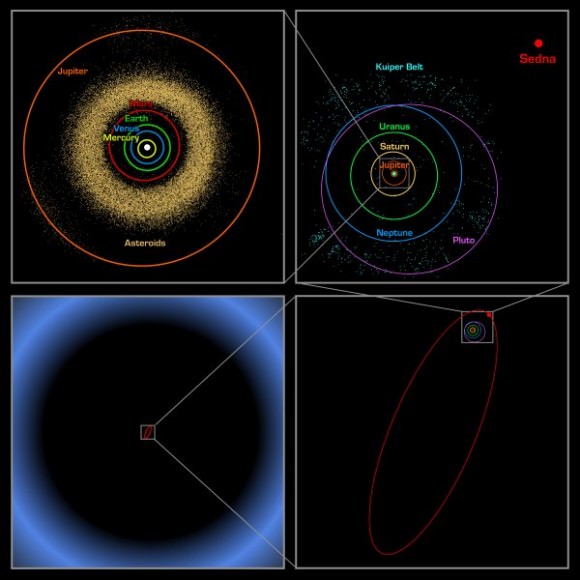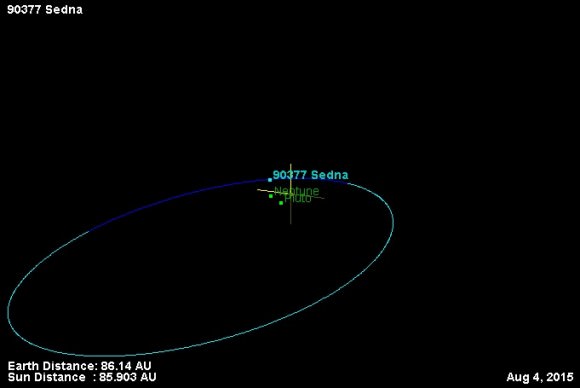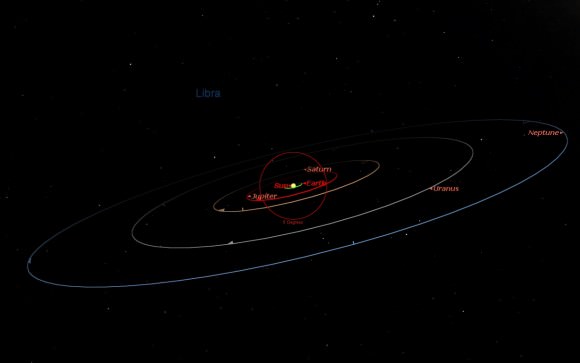Turns out, our seemly placid star had a criminal youth of cosmic proportions.
A recent study out from Leiden Observatory and Cornell University may shed light on the curious case of one of the solar system’s more exotic objects: 90377 Sedna.

A team led by astronomer Mike Brown discovered 90377 Sedna in late 2003. Provisionally named 2003 VB12, the object later received the name Sedna from the International Astronomical Union, after the Inuit goddess of the sea.
From the start, Sedna was an odd-ball. Its 11,400 year orbit takes it from a perihelion of 76 astronomical units (for context, Neptune is an average of 30 AUs from the Sun) to an amazing 936 AUs from the Sun. (A thousand AUs is 1.6% of a light year, and 0.4% of the way to Proxima Centauri, the closest star to our solar system). Currently at a distance of 86 AU and headed towards perihelion in 2076, we’re lucky we caught Sedna as it ‘neared’ (we use the term ‘near’ loosely in this case!) the Sun.
But this strange path makes you wonder what else is out there, and how Sedna wound up in such an eccentric orbit.

The study, entitled How Sedna and family were captured in a close encounter with a solar sibling looks at the possibility that Sedna may have been snatched from another star early on in our Sun’s career (of interstellar crime, perhaps?) The team used supercomputer simulations modeling 10,000 encounters to discover which types of near stellar passages might result in an ice dwarf world in a Sedna-like orbit.
“We constrained the parent star of Sedna to have between one and two times the mass of the Sun and its closest approach to be 200-400 AUs,” Dr. Lucie Jilkova of Leiden Observatory told Universe Today. “Such a close encounter probably happened while the Sun was still a member of its birth star cluster — a family of about 1,000 stars, so called solar siblings, born at the same time relatively close together — which was about 4 billion years ago.”

The best fit for what we see today in the outer solar system in the case of Sedna, is a close (340 AU) passage from the Sun — that’s over 11 times Neptune’s distance — of a 1.8 solar mass star inclined at an angle of 17-34 degrees to the ecliptic. Sedna’s current orbital inclination is 12 degrees.
Rise of the Sednitos
The paper assigns the term ‘Sednitos’ (also sometimes referred to as ‘Sednoids’) for these Edgeworth-Kuiper Belt intruders with similar characteristics to Sedna. In 2012, 2012 VP113, dubbed the ‘twin of Sedna,’ was discovered by astronomers at the Cerro Tololo Inter-American Observatory in a similar looping orbit. The ‘VP’ designation earned the as yet unnamed remote world the brief nickname ‘Biden’ after U.S. Vice President Joe Biden… hey, it was an election year.
There’s good reason to believe something(s?) out there shepherding these Senitos into a similar orbit with a comparable argument of perihelion. Researchers have suggested the existence of one or several planetary mass objects loitering out in the 200-250 AU range of the outer solar system… note that this is
a separate scientific-based discussion versus any would-be Nibiru related non-sense, don’t even get
us started…
If researchers in the study are correct, Sedna may have lots of company, with perhaps 930 planetesimals predicted in the ‘Sednito region’ of the solar system from 50 to 1,000 AUs and 430 more additional planetesimals littering the inner Oort cloud from the same early event.
“We focused on a particular example of a stellar encounter with characteristics from the ranges mentioned,” Dr. Jilkova said. “For this example, we estimated that there would be about 430 bodies similar to Sedna in the outer solar system (beyond 75 AU).”
Fun fact: One possible controversial candidate for the birth cluster of Sol and our solar system is the open cluster M67 in Cancer. It’s an intriguing notion to try and track down the star we stole Sedna from 4 billion years ago using spectral analysis, though researchers in the study point out that the other more massive star is probably an aging white dwarf by now.
Astronomy from the surface of Sedna is mind-bending to contemplate. Currently 86 AU from the Sun and headed towards perihelion in 2076, Sol would appear only 20” across from the surface of Sedna, but would still shine at magnitude -17 to -18 near perihelion, about 40 to 100 times brighter than a Full Moon. Fast forward about 5,500 years towards aphelion, however, and the Sun would dim to a paltry magnitude -12, a full magnitude (2.5 times) dimmer than the Full Moon.

Shining at magnitude +21 in the constellation Taurus, astronomers know little else about Sedna. Based on brightness estimates, Sedna measures about 1,000 km in diameter. It does appear to be the reddest object in the solar system, and may turn out to be the ‘red twin of Pluto’ as recently revealed by NASA’s New Horizons spacecraft, complete with a surface rich in tholins.
And a new generation of observatories may uncover a treasure trove of Sednitos. The European Space Agency’s Gaia astrometry mission should uncover lots of new asteroids, comets, exoplanets and distant Kuiper Belt objects as a spin-off to its primary mission. Then there’s the Large Synoptic Survey Telescope, set to see first light in 2019.
“The key piece of the puzzle is to actually observe more Sedna-like objects.” Dr Jilkova said. “Currently, we know only of two such bodies. More discoveries are expected in the following years and they will shed light on the origin of Sedna and its family and the ‘criminal record’ of the Sun.”
It’s a fascinating story of interstellar whodunit for sure, as our Sun’s early days of wanton juvenile delinquency unravel before the eyes of modern day astronomical detectives.


And teasing out isotope variances from the solar system, perhaps under a layer of crust, would be primordial before coming to the solar system.
And Sedna goes in and out of the heliosphere. So there could be layering in the crust from such transitions AND for affects of passing stars and even some of their explosions. And perhaps changes in the orientation of the heliosphere (which isn’t a sphere only.)
But we don’t know yet how to really tease out these details so if we went we wouldn’t know what to look for. But we’re edging there, eh?
Like we could look at moons moving in and out of sheaths around planets for such layers….
Good points… maybe a fast ‘Sedna flyby’ should be next on the space exploration agenda…
You might want to reconsider ‘fast’ given Sedna will be 75 AUs at perihelion… It might be a good target for a prototype interstellar probe. Bring on the exotic propulsion systems.
If there’s a close encounter with another star, the Sun probably does not need to steal a KBO from the other star to end up with a Sedna-like object. The encounter would likely perturb some of the Sun’s own KBOs into similar orbits.
If the Sun had a close enough encounter to grab Sedna and pull it into within the Oort cloud, after 4.5 B years of close encounters, is there much of an Oort cloud left? As far as I know, no Oort cloud object has ever been observed so it’s existence remains hypothetical. Even if it did exist at one time, it ought to be in pretty ratty condition by now.
Great article but you mentioned Nibiru which will probably bring some strange objects in from their outer orbits.
If the Sun and the other star were close enough for our Sun to grab Sedna from a (supposedly) more massive star, what would that have done to the planets in our own solar system?
Wouldn’t it make more sense that Sedna started as a Kuiper belt object (like, say, Pluto) and disturbed by the close passage of another star than we got to snatch it from that other star? Did they do simulations on that one?
They did. The odds are low.
http://www.mikebrownsplanets.com/2010/10/theres-something-out-there-part-2.html
Awesome. Bring on the planets.
Since Sedna is now approaching towars nearest point towards sun we should send a probe like new horizon within a decade so that a fly by can be possible. This is opportunity for whole human being to do some scientific observation on a object which has aphelion around 1000 AU. This could be 1st step for first interstellar mission. If we launch a probe by now it should reach sedna around 25 to 30yrs of time. We can view Sedna’s close up pic in our life time. Nasa or 100 yss team should look into this.
If there are planets at 200-250 AU shepherding these “Sednitos,” would those planets also have been captured from another star system?
You’d think. I have hunch that LSST and Gaia will push back the constraints of what could exist in the far outer solar system within the next decade.
It depends on where they were in their orbits… a LOT of objects in between the two stars might have been exchanged, but those on their farsides would have barely been perturbed at all. It’s fascinating to think about what we might find lurking out there with the next gen telescopes…
Perhaps our sun was born a twin in a binary configuration. (I think such twins are the norm actually.) Lots of icy objects (Sednas?) could have formed and lingered at an L. point between such twins. Then later, via a close encounter with a third star, we lost our twin and many of those icy objects found their way into our (cooled) inner solar system bombarding earth, mars, etc. with ice/water. Are there computer simulations for this scenario which make it reasonable?
Given the recent New Horizon’s fly-by of Pluto and it’s diminutive moons, we might eventually squeeze out of the data, that one of more of them (Including Pluto) were actually captured Oort cloud or Kuiper Belt objects. OR their spectroscopy might indicate they were formed around an entirely different star and gravitationally captured by Sol!
We are all excited by THAT possibility and continuing data stream!
Do Haumea next!
Will we discover the first object beyond 100 au before 2020? There is a real possibility that of the hundreds of Sedna-like objects in the inner Oort cloud, some could be as big as Pluto or Eris, or even bigger. Sedna and 2012 VP113 could just represent the tip of the iceberg, as Pluto was for more than 60 years for the Kuiper Belt. BTW, scattered disc object 2001 UR163, a 600 km (estimated) dwarf planet currently 50.6 au from the Sun is the reddest object in the Solar System, even redder than Pholus and Sedna.
With some luck, Gaia space telescope will observe some random microlensing events of objects out there. Its data is certainly being looked into with that in mind. We might get an Oort object discovery boom like we have had an exoplanet discovery boom. Maybe much of the Oort cloud will turn out to be interstellar? Today even its existence is uncertain. Maybe there are interstellar comets flying around nearby here. Maybe that’s a clue to why deuterium on Earth doesn’t match with domestic comets. Maybe the late heavy bombardment was an interstellar event. Maybe (and on and on).
Great! We can go interstellar less than 100 AU from here. It is doable today! A probe sent to Jupiter to gravitationally halt its orbital speed and fall in toward the Sun. There it uses a huge solar sail to accelerate, which then is ejected a few AU away while the nuclear ion thruster accelerates during a decade. Or something more clever, or simpler. Exoplanet, here we come!
Sedna might have formed in a very different environment than other KBO or Oort objects. At another kind of star. A mission to Sedna should be a high priority now, if its extrasolar origin is valid.
And a great discovery, fit for the history books. As classic as predicting Neptune.
Maybe it is much much older than the Solar System. Maybe it has been a vagabond planet for ten billion years. Maybe it was ejected by a star going supernova turning into a black hole. Who knows where it has been. I think that Sedna suddenly became very important for our understanding of the world and everything.
Once, I did some preliminary calculations for a probe that would use the Jupiter “drop maneuver” and then an Oberth boost near the Sun. Maybe use ammonia (or water) to cool the Sun facing side of the spacecraft and expel it as a propellant at 2000+K temperature. It would be a huge craft since you’d be getting tens of megawatts of power per square meter of exposed surface at perihelion. The closest passage at ~500km/s would only take an hour or two, but you’d probably need to cool the craft a day or two (or more) before and after perihelion. (You could have smaller exposed surface then.)
I’m not really sure I calculated right, but if I remember correcly I got about +80 km/s at infinity for a relatively small dV at perihelion.. +10 km/s or so.
Anyways, after perihelion the craft would dump the ammonia/water tank and open its electric sail, using the nuclear reactor (which was used to pump ammonia earlier) to power the sail. At some distance from sun the sail part would be discarded and from there on it could use ion thrusters to increase its speed even more.
Well, this is just a thought, someone should make the calculations to verify if the idea is really possible in this universe and what solar escape velocities are actually achievable. 🙂
Great comments! 500 km/s is ambitious. Solar Probe Plus I think will have a max speed of 200 km/s, and it will be sweating. But if we build the probe out of carbon and tungsten and and… and a tooth fairy and…
SLS is five times more powerful than the thing that launched New Horizons to Pluto in ten years. If Tsiolkovskis rocket equation as I understand it is applicable here, 5 times the effort only gives 60% more result. That adds up to too many decades in my personal equation. Sun flyby is maybe crazy, but doing it the old style just won’t happen, for psychological organizational reasons, I’m afraid, because we age. Someone has to come up with a good idea to make a mission to Sedna happen. I’m pretty clueless, but simply paying more for more rockets would be an attractive idea to me. It’s worth it. We’d just waste that money otherwise anyway.
Can Sedna be a gravitational exchange from other solar systems to our sun due to gravitational attraction when the stars have passed close to each other?
May the eccentric orbit indicate it wasn’t made from the same protoplanetar disc as the other planets.
This is bad! With planets and dwarf planets so far away from the Sun, they could easily be stolen by another star. Get your act together, Sun, and collect your belongings or you with LOSE THEM! 😉
It is not so easy to capture something. The relative speeds are so large, and they need to be pretty precise in order for a capture to happen. It’s the same math that explains why New Horizons couldn’t stay at Pluto. I think Sedna most likely was captured from a star which formed in the same nebula as the Sun, moving along with us 4½ billion years ago. So it might not be that very exotic in composition and age (but it could be).
A planetesimal formed around another star in our original nebula could actually be scientifically more interesting than a random exoplanet would be. It has some context we can understand. Maybe even its mother star can be identified from its composition, if it still follows us.
I’m just waiting for an Oort cloud member or Kuiper belt member or whatever to turn up with an orbit that’s inclined 90 degrees to the ecliptic. THAT will get the close encounter and capture theo …. no, not theories … guesses, *really* humming!
very poor article,..without scientific background,…